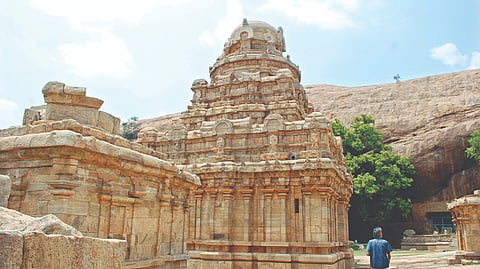

TIRUCHY: Pudukottai district which boasts of a rich cultural heritage with magnificent forts, palaces and amazing cave paintings is crying for attention. Archaeological enthusiasts who are worried about the forgotten glory of the erstwhile princely state are pushing for a tourism package which would promote the glorious past.
If the Trichy sub circle of Archaeological Survey of India (ASI), bifurcated from the Chennai circle has 167 archaeologically important places, Pudukottai district alone contributes 113 places to the list. It speaks volumes on the importance of promoting Pudukottai as a hub for cultural tourism, said archaeological enthusiasts.
“If the authorities devise a two day package tour it would be sufficient to cover almost all the landmark locations,” said S Jayaprakash, an archaeological enthusiast. “These sites can be covered within a 80 km range. It would go a long way to instil awareness about historical monuments,” he added.
The renowned Sittanavasal cave paintings site is just 17 km away from Pudukottai town. As many as 17 Jain stone bed sites and cave paintings on par with Ajanta-Ellora cave painting and cave temples are within reach from the Pudukottai town. The sites showcase the ancient traces of Jains in Tamil Nadu.
Promoting Pudukottai district, which has been revered as the treasure trove of Tamil Nadu, would boost tourism if a package tour covering all the monuments and sites is promoted, express the archaeological enthusiasts. They have planned to approach the government to rope in both the tourism and archaeological department to spearhead the plan.
“The Thirumayam fort, which is said to be constructed by one of the famous kings Kizhavan Sethupathy in 1687, is also not far away from Pudukottai town. It’s not just Jain sites, there are separate cave temples dedicated for Lord Shiva and Vishnu,” said Jayaprakash.
Similarly Narthamalai located 17 km from Pudukottai town, considered to be the headquarters of the erstwhile Mutharaiyar kings, has the rock temple of Vijayalaya Choleeswaram and Kadambarmalai cave temple which has an aesthetic appeal. “Hundreds of monuments are lying unexplored in the district,” lamented Jayaprakash.
Founder of Pudukottai District Archaeological Research Centre A Manikandan has urged the district administration and the state government to train the students on the excavation process, apart from creating awareness about unexplored sites. “It will not merely help them gain knowledge in the domain but also would help in employment generation,” he said.
“The package tour on archaeological sites would help in exploration of the sites as well as instilling knowledge among the present generation about the past history and heritage,” Manikandan added.
Etched in music: The story of Kudumiyanmalai musical inscriptions
Much before modern musical notations took roots in the West, classical ragas were inscripted in Kudumiyanmalai temple in Pudukottai. The inscriptions from the 7th century AD carved on hard rocks of the cave temple contain classical ragas.
Built during the Pallava era, the temple stands testimony for king Mahendravarman’s expertise in music composition. He is said to have coined a new composition of Sangeernasadhi raga and carved it in Devanagari script.
It is said that Mahendravarman, also called Pallava I, ruled over the place between 630 and 660 AD. The music inscriptions are etched on rocks measuring 13 feet width and 14 feet length.
According to the researchers, Kudumiyanmalai inscriptions have seven sub sections which have the words like Madhyama grame, Sadja grame, Panchmi and Kaisiki Madyama, connected with music. The notations on the inscription have been coined for the veena instrument with seven strings but it can also be used for eight stringed veena. The inscription carries information on how they could be played with both.
Kudumiyanmalai was the major place for Pandiya, Chola, Vanadhirayar, Mutharaiyyar and Thondaiman kings. Though the place is under the control of ASI, the Tamil Nadu HR and CE department takes care of the temple and the devotees, cultural enthusiasts are allowed during morning and evening hours.
Porpanaikottai excavation aims to trace Indian history to Cauvery
The commencement of excavation in search of Sangam era fort in Porpanaikottai, Pudukottai district has brought the focus back on river Cauvery and its influence on ancient Tamil civilization. “More than 200 pieces of archaeological evidence were found that would trace Indian history to the banks of river Cauvery,” said A Manikandan, Founder, Pudukottai District Archaeological Research Centre.
The Archaeological department of Tami Nadu has obtained permission from the ASI and commenced the excavation process at Porpanaikottai on Saturday. Minister of Archaeology Thangam Thennarasu inaugurated the phase-I of the excavation. According to the officials, the Light Detection and Ranging (LIDAR) method of sensing has estimated the fort at Porpanaikottai could be spread in a sprawling 17.7 acres out of which the habitation area was estimated to be around 1.2 acre.
Manikandan and his team have been demanding an excavation process at Porpanaikottai for years, handing over several hundreds of ancient materials to the department of Archaeology. “The radar sensor method has found that the Porpanakottai region ages back over 3000 years and the people were highly civilised,” said Manikandan.
Several materials like conch bangles, glass beads, ear rings, iron nails, earthen jars, weapons made of bones and other artefacts made of clay were found in the region earlier which stand testimony for the potential of the archaeological site. “These may well establish trade and commerce capabilities of ancient Tamils, spanning multiple countries,” Manikandan added.
Visit news.dtnext.in to explore our interactive epaper!
Download the DT Next app for more exciting features!
Click here for iOS
Click here for Android